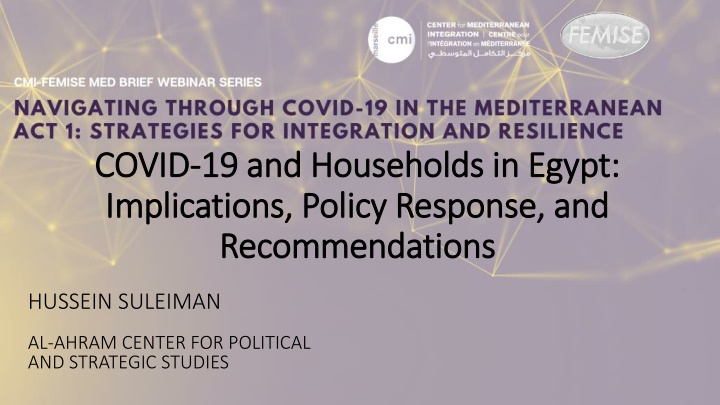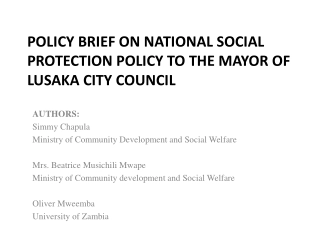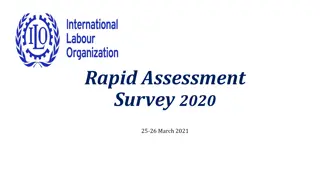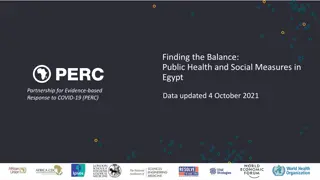
COVID-19 Impact on Households in Egypt: Policy Response & Recommendations
Egypt's response to the COVID-19 crisis and its implications on households and vulnerable groups, including changes in employment conditions, income levels, and government policy measures to alleviate economic disruptions.
Download Presentation

Please find below an Image/Link to download the presentation.
The content on the website is provided AS IS for your information and personal use only. It may not be sold, licensed, or shared on other websites without obtaining consent from the author. If you encounter any issues during the download, it is possible that the publisher has removed the file from their server.
You are allowed to download the files provided on this website for personal or commercial use, subject to the condition that they are used lawfully. All files are the property of their respective owners.
The content on the website is provided AS IS for your information and personal use only. It may not be sold, licensed, or shared on other websites without obtaining consent from the author.
E N D
Presentation Transcript
COVID COVID- -19 and Households in 19 and Households in Egypt Implications, Policy Implications, Policy Response Recommendations Recommendations Egypt: : , and Response, and HUSSEIN SULEIMAN AL-AHRAM CENTER FOR POLITICAL AND STRATEGIC STUDIES
Channels of Impact on Households Egypt has adopted mild lockdown measures during the covid-19 crisis, to avoid an economic meltdown and a domestic supply shock. Nevertheless, the global crisis has impacted foreign demand for crucial exports and sources of household income and employment. Tourism sector, which contributes with 10% of total employment, and 4.3% of GDP, had its receipts fall by -55% in Q1 &Q2 YoY. Remittances, amounting to 8.8% of GDP, are projected to decline by - 9% in 2020. Suez Canal revenues, which contribute with 2% of GDP, declined in the first 10 months of 2020 by -4.4%
Implications on Households and Vulnerable Groups The Covid-19 crisis came when Egypt has just completed a 3-year reform program, between 2016 and 2019, which had negative impact on vulnerable groups. Poverty increased from 27.9% in 2015 pre-reform program, to 32.5% in 2018, the latest official data. Extreme poverty increased from 5.3% in 2015 to 6.2% in 2018. Women participation in the workforce declined from 7 million in 2016, to less than 5 million in 2019, as informality of work surged during the reform years, which mostly attracts male labour.
Implications on Households and Vulnerable Groups At the peak of the Covid-19 crisis, employment conditions of 61.9% of all working individuals in Egypt have changed, with 4 million people becoming unemployed, which improved in recent months. Income has fallen during the crisis for 73.5% of all working Egyptians. Females, youth, and people with lower education levels were most hit by the crisis, in terms of impact on employment status and income. Informal workers in specific, who constitute more than half of all non- agricultural labour in Egypt, are specifically vulnerable to the crisis. Nearly 43.1% of them are poor, and they lack safety nets or savings.
Governments Policy Response The government dedicated 100 billion Egyptian pounds, nearly 1.8% of GDP, as a stimulus package, half of which is for tourism sector alone. The Central Bank dedicated additional 100 billion pounds of subsidized loans to the business sector, besides additional smaller scale relief measures. Smaller share of the package is dedicated to households, with measures that include cash grants to irregular workers, besides raising pensions, public wages, and income tax exemptions. Simultaneously, the government is aiming to have a primary budget surplus during the crisis, by targeting households to raise more revenues. 1% of all employees incomes have been deducted, in addition to 0.5% of all pensions, besides increasing energy prices for households and imposing extra fees on government services. In total, the fiscal cost of the measures was 0.756% of GDP by mid-2020, with only 0.052% in support to households, while additional revenues of 0.549% of GDP are planned, almost entirely targeting households.
Managing the Crisis Implications on Households The government has lifted most of restrictions by July, and has simultaneously cut back most of the relief and stimulus measures, despite the lasting impact of the crisis. On the short term, the government would need to increase cash transfers to the most affected and most vulnerable groups, in terms of number of recipients and amount per recipient. The government should also be ready to run a fiscal deficit during the crisis to finance the measures and avoid burdening households during the crisis. It should also consider redistributing support from businesses to households. On a longer term, more public investments would be needed in education, integrating informal labour in social safety nets, and digital transformation. Business environment and regulations would also need attention and reform to help boosting inclusive growth and creating job opportunities.


![[PDF⚡READ❤ONLINE] Tutankhamun's Trumpet: Ancient Egypt in 100 Objects from the](/thumb/20549/pdf-read-online-tutankhamun-s-trumpet-ancient-egypt-in-100-objects-from-the.jpg)



















